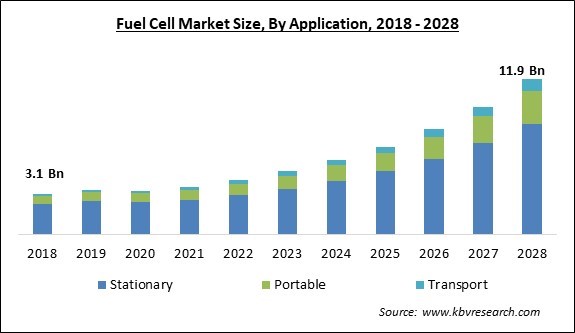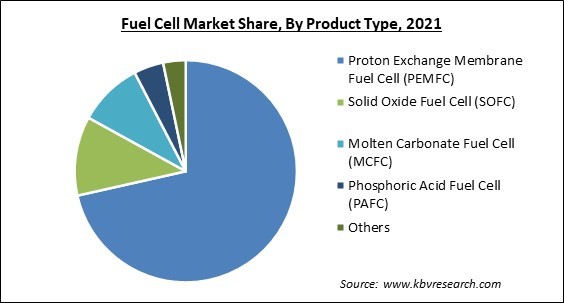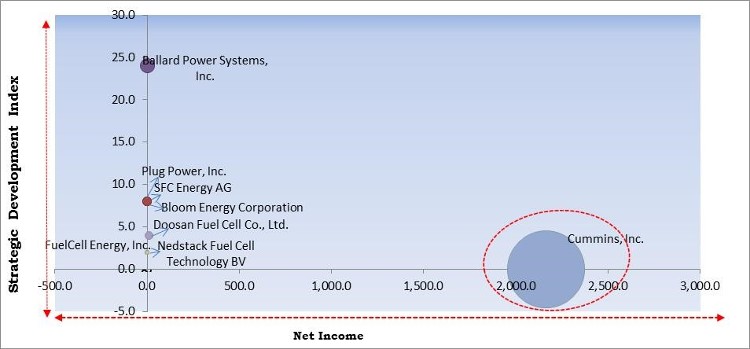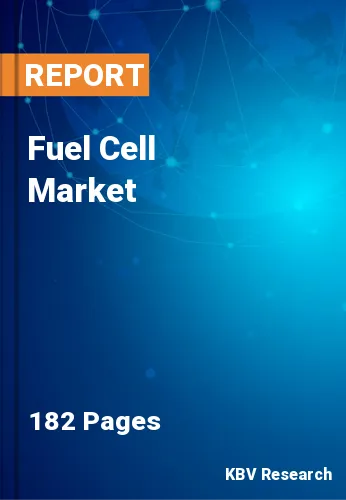The Global Fuel Cell Market size is expected to reach $11.9 billion by 2028, rising at a market growth of 19.2% CAGR during the forecast period.
Fuel cells are energy-producing devices that use sustainable chemical reactions to generate energy. The demand for fuel cells is likely to grow owing to the competitive advantages of fuel cells, which include increased efficiency, environmental friendliness, and a longer life duration than competing technologies. Factors such as stringent government rules about pollution from conventional sources, growth in distributed power generation, and the advantages of fuel cells over other power generation technologies would act as the growth catalysts for the industry.
Fuel cell applications in the transportation sector, including vehicles and buses, are likely to drive market expansion in the coming years. In addition, rising demand for portable devices and improved fuel cell efficiency are some of the key trends in the market. As people become more aware of the benefits of fuel cells, their influence is projected to grow dramatically. The high cost of catalysts used in fuel cells, which raises the cost of fuel cells, and the lack of fuel cell infrastructure are two of the major barriers to the growth of the market. However, fuel cell costs are likely to decrease in the future years as technology advances.
The trade of fuel cells, which are primarily used in electric motors and generators, was valued at $19.2 billion in 2018, as per the International Trade Center (ITC). Fuel cells are essential components of many devices that transform chemical energy into electrical energy, and they have a wide range of home and commercial applications. However, the high cost of fuel cell devices and a lack of fuel infrastructure are limiting the growth of the market. On the other hand, increased investment in fuel cell R&D to improve operating efficiency is expected to generate prospective growth prospects in the coming years.

Due to the COVID-19 pandemic, a temporary ban on import and export, as well as manufacturing and processing activities, was implemented across many industries and electrical utilities, reducing demand for fuel cells from these customers. In addition, due to a lack of personnel, a pause in the development of new electric utility infrastructures, renewable power plants, grid networks, and other power plants, as well as a rise in the demand-supply gap, market growth is expected to be hampered throughout the pandemic period. As a result, market growth in the second, third, and fourth quarters of 2020 has slowed. However, by the end of 2021, the fuel cell market has rebounded due to the availability of the COVID-19 vaccine in a number of economies throughout the world, which is predicted to boost the global economy.
Fuel cells systems are increasingly being used to generate combined heat and power (CHP) for powering and heating small households as well as commercial spaces such as hotels, hospitals, educational institutions, public buildings, and other similar structures. As a result, different state and federal governments have enacted advantageous regulatory frameworks and subsidy programs to encourage the integration of devices into a variety of applications. For example, the state of New Jersey has modified its financial incentives for FC CHP installations completed on or after October 1, 2020. Its CHP-FC Program framework is meant to help more firms succeed by providing financial assistance of up to USD 3 million per project.
Due to tremendous growth in the regional transportation sector and high fossil fuel use, environmental challenges such as climate change and poor air quality have arisen, necessitating the use of clean energy sources. Fuel cells produce no pollutants and help to reduce greenhouse gas emissions. Fuel cells primarily employ hydrogen or methanol, which reduces economic reliance on oil and gas while improving energy security. The demand for the vehicular fuel cell is credited to the rising environmental concerns and expanding infrastructure connected to hydrogen refilling stations over the forecast period.
Bipolar plates, catalysts, membrane electrode assemblies (MEAs), gaskets, and other components are used in the production of FC systems. As a result, these products are quite costly, and manufacturing a limited number of FC systems may result in unacceptably high prices for the manufacturers. Furthermore, the market prospects may be hampered by the restricted availability of critical high-tech hydrogen infrastructure in numerous countries. On the other hand, government divisions such as the United States Department of Energy (DOE) are constantly taking initiatives to introduce financial support and benefits in order to bridge the gap and allow manufacturers and customers to use zero-emission technologies.

Based on Product Type, the market is segmented into Proton Exchange Membrane Fuel Cell (PEMFC), Solid Oxide Fuel Cell (SOFC), Molten Carbonate Fuel Cell (MCFC), Phosphoric Acid Fuel Cell (PAFC), and Others. In 2021, the Solid Oxide Fuel Cell segment acquired a significant revenue share of the Fuel Cell Market. High CHP efficiency, fuel flexibility, and high-power output during processes ranging up to several megawatts are just a few of the advantages SOFC has over other options. As a result, their increasing usage is likely to boost segment growth. One of the key advantages of SOFCs is that there is no requirement for electrolyte loss. Furthermore, their capacity to operate at high temperatures eliminates the need for expensive catalysts like ruthenium. SOFCs are most commonly used in stationary applications.
Based on Application, the market is segmented into Stationary, Portable, and Transport. The Transport Segment garnered a promising revenue share of the Fuel Cell Market in 2021. This is due to the widespread use of fuel cell technology in heavy-duty operations such as public transportation in regions such as the Asia Pacific. In addition, the growth of the segment would be driven by the increasing demand for fuel cell automobiles and fuel cell-powered forklifts. Furthermore, increased research and development initiatives in Europe to produce hydrogen-powered hybrid vehicles are expected to propel the segment forward.
| Report Attribute | Details |
|---|---|
| Market size value in 2021 | USD 3.6 Billion |
| Market size forecast in 2028 | USD 11.9 Billion |
| Base Year | 2021 |
| Historical Period | 2018 to 2020 |
| Forecast Period | 2022 to 2028 |
| Revenue Growth Rate | CAGR of 19.2% from 2022 to 2028 |
| Number of Pages | 182 |
| Number of Tables | 283 |
| Report coverage | Market Trends, Revenue Estimation and Forecast, Segmentation Analysis, Regional and Country Breakdown, Competitive Landscape, Companies Strategic Developments, Company Profiling |
| Segments covered | Product Type, Application, Region |
| Country scope | US, Canada, Mexico, Germany, UK, France, Russia, Spain, Italy, China, Japan, India, South Korea, Singapore, Malaysia, Brazil, Argentina, UAE, Saudi Arabia, South Africa, Nigeria |
| Growth Drivers |
|
| Restraints |
|
Based on Regions, the market is segmented into North America, Europe, Asia Pacific, and Latin America, Middle East & Africa. In 2021, the APAC emerged as the leading region in the overall Fuel Cell Market. The growth of the regional market can be attributed to the availability of a large customer base, quick development of the hydrogen sector, fuel cell systems, and the presence of significant businesses in the region. Moreover, the presence of emerging nations in Asia-Pacific, including China, Japan, India, and South Korea, is expected to raise demand for fuel cells in transportation applications, contributing to the growth of the Asia-Pacific fuel cell market.
Free Valuable Insights: Global Fuel Cell Market size to reach USD 11.9 Billion by 2028

The major strategies followed by the market participants are Partnerships. Based on the Analysis presented in the Cardinal matrix; Cummins, Inc. is the forerunners in the Fuel Cell Market. Companies such as Ballard Power Systems, Inc., Plug Power, Inc., Doosan Fuel Cell Co., Ltd. are some of the key innovators in the Market.
The market research report covers the analysis of key stake holders of the market. Key companies profiled in the report include Ballard Power Systems, Inc., Plug Power, Inc., SFC Energy AG, Bloom Energy Corporation, Cummins, Inc., Hyster-Yale Materials Handling, Inc., Doosan Fuel Cell Co., Ltd., Intelligent Energy Limited (Meditor Group), FuelCell Energy, Inc., and Nedstack Fuel Cell Technology BV.
By Product Type
By Application
By Geography
The global fuel cell market size is expected to reach $12.1 billion by 2028.
The growing number of Vehicular Applications are driving the market in coming years, however, the need for massive initial investments and rising use of renewable energy growth of the market.
Ballard Power Systems, Inc., Plug Power, Inc., SFC Energy AG, Bloom Energy Corporation, Cummins, Inc., Hyster-Yale Materials Handling, Inc., Doosan Fuel Cell Co., Ltd., Intelligent Energy Limited (Meditor Group), FuelCell Energy, Inc., and Nedstack Fuel Cell Technology BV.
The expected CAGR of the fuel cell market is 19.2% from 2022 to 2028.
The Stationary segment acquired maximum revenue share in the Global Fuel Cell Market by Application in 2021, thereby, achieving a market value of $8.5 billion by 2028.
The Asia Pacific market dominated the Global Fuel Cell Market by Region in 2021, and would continue to be a dominant market till 2028.
Our team of dedicated experts can provide you with attractive expansion opportunities for your business.

